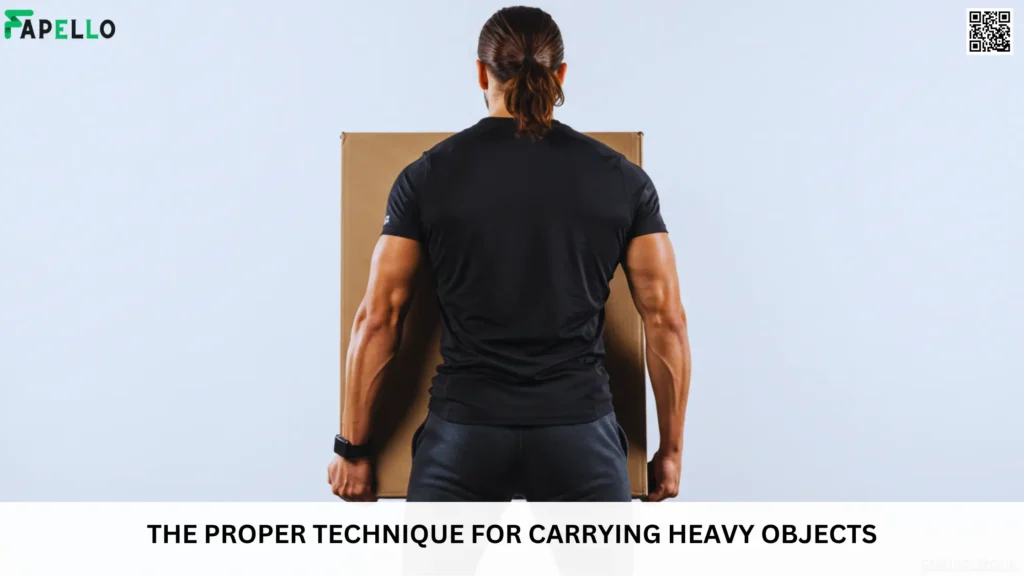Lifting and carrying heavy objects isn’t necessarily bad for you. In fact, if you do it in the right way, it’s extremely good exercise.
Problems arise, however, when lifting and carrying are done in the wrong way. This can expose the person doing the lifting to severe risk. This can occur even if the object in question is relatively small: office employees carrying boxes of files might underestimate the load in a way that construction workers hauling bags of cement would not.
If the lifting is being performed at work, then it might even have legal consequences: employers owe a legal duty of care to their staff and therefore must provide the right training, equipment, and supervision to any person charged with lifting or carrying heavy objects. Manual handling injuries can often result in legal action.

So, what’s the right way to lift?
Warm up and stretch
Injuries are most likely when the exercise in question is being performed ‘from cold’. The first object you lift might therefore present the greatest risk.
This creates a challenge for people who lift infrequently. You can lessen the risk by warming up properly prior to the lift. Stretch the muscles that you know are going to be loaded. This might mean your legs, back, and shoulders. If you know the stretches and you’re comfortable doing them, you’ll be able to cut your risk significantly over a lifetime of lifting. What’s more, you might be able to take up exercise – which can bring benefits of its own.
Assess the load
Your body has limits – even if it’s sufficiently warmed up. You should be able to assess the weight of a given object and know how to abandon the lift safely if you think that it’s going to push you too far. Sometimes, objects can be difficult not because of their weight, but because of their shape.
You might split the load, where possible, or divide it between many people. In a warehouse setting, you might have access to special equipment designed to reduce the risk. Forklifts and dollies can often make a crucial difference to your safety in the workplace.
Practice good lifting techniques
There’s a good way and a bad way to lift any object. Ideally, you should keep your feet apart, so that your body is stable. Bend from the knees, keeping your back straight and shoulders level and parallel with your hips. Make sure that the load is close to your body so that its weight pushes down through your legs.
When depositing an object, make sure that you follow this procedure, but in reverse. Above all, make sure that you keep your back straight!
Adjust afterwards
Don’t feel that you have to perform the complete move in a single go. Put the object down if you need to rethink, and then take it up again. This will help you avoid taking unnecessary risks, and give you a break at the same time.
Source: Fapello in UK
Why Correct Lifting Matters More Than You Think
Musculoskeletal disorders (MSDs) like lower back injuries, shoulder strains, and knee problems are often linked to incorrect manual handling. In workplaces, this issue costs billions annually. According to the UK Health and Safety Executive, manual handling injuries account for over 30% of all workplace-related musculoskeletal complaints. And at home? Those stats are underreported but just as relevant. Everyone, from delivery drivers to school janitors to office staff lifting paper boxes, needs to be mindful of how the body moves under load.
What Happens When You Lift Incorrectly?
Lifting without proper form doesn’t just cause discomfort. It can lead to:
- Spinal disc compression
- Muscle tears or ligament sprains
- Knee joint degeneration
- Shoulder impingement
- Chronic lower back pain
These injuries often creep up slowly, starting as mild stiffness and eventually interfering with your daily activities.
Benefits of Lifting With Correct Technique
When you apply biomechanics correctly, you’re not just avoiding injury — you’re building resilience. Some advantages include:
- Improved posture and spinal health
- Enhanced core strength
- More efficient energy use during tasks
- Increased joint stability
- Reduced risk of repetitive strain injuries (RSIs)
This applies not just in workplaces with manual labor but in routine tasks like gardening, picking up children, or moving groceries.
How Do I Know if Something’s Safe to Lift?
Before even touching an object, it’s essential to evaluate its characteristics. That’s part of a risk assessment, a term often used in occupational safety but just as useful for everyday lifting.
Ask Yourself:
- How much does the object weigh?
- Can I get a good grip on it?
- Is it awkwardly shaped or unbalanced?
- Do I have a clear path to carry it?
- Do I need mechanical aid or another person to help?
A study by the National Institute for Occupational Safety and Health (NIOSH) shows that objects weighing over 23 kg (about 50 lbs) significantly increase injury risk without assistance or lifting devices.
How to Prepare Your Body Before Lifting
Jumping straight into lifting cold muscles can set you up for injury. That’s why warming up and stretching your major muscle groups is critical.
Focus Areas:
- Hamstrings and quadriceps: These power your lift.
- Lower back (erector spinae): Stabilizes the spine.
- Shoulders and traps: Support the upper load.
- Calves and ankles: Maintain balance and foot positioning.
A Quick Warm-Up Routine:
- March in place for 60 seconds
- Gentle squats (10 reps)
- Arm circles and shoulder rolls
- Standing hamstring stretch
- Calf raises (10 reps)
Prepping your body activates proprioceptors, improving joint awareness and reducing risk.
What Is the Best Body Position When Lifting?
Biomechanics is your best friend when it comes to manual handling. It’s all about alignment, control, and balance.
Step-by-Step Guide:
- Stand close to the object – Keep the load near your center of gravity.
- Place your feet shoulder-width apart – Creates a stable base.
- Bend at the hips and knees – Never from the waist.
- Keep your back straight – Avoid rounding or arching.
- Grip firmly using your palms – Avoid relying on fingertips.
- Lift smoothly – Use your leg muscles, not your back.
Avoid twisting your torso mid-lift. If you need to turn, move your feet — not your spine.
How to Carry the Load Safely
Once the item is lifted, carrying it properly is just as important as lifting.
- Hold the object close to your body
- Keep your head up and shoulders level
- Walk slowly, with deliberate steps
- Avoid sudden movements
- Use carts, dollies, or trolleys whenever possible
Equipment That Helps:
| Equipment | Use Case | Example Task |
|---|---|---|
| Hand Truck | Tall, stackable boxes | Moving archive files |
| Pallet Jack | Heavy items on pallets | Warehouse distribution |
| Furniture Dolly | Large, flat-bottomed objects | Moving desks or cabinets |
| Lifting Straps | Distributes weight across larger muscles | Team lifting a couch or mattress |
When Should I Ask for Help or Use Equipment?
Don’t let pride override safety. Here are signs it’s time to ask for assistance:
- The object blocks your view
- You can’t grip it securely
- You feel off-balance while holding it
- It exceeds 20–25% of your body weight
- It needs to be lifted overhead
Common Manual Handling Mistakes to Avoid
Even if you’re well-intentioned, it’s easy to make mistakes without realizing:
- Holding the object too far from your body
- Lifting with your back
- Jerky or rushed movements
- Wearing improper footwear
- Ignoring pre-existing injuries
Being mindful of these helps prevent both acute injuries and chronic strain.
Why Repetitive Lifting Requires Extra Caution
Repetitive strain injuries (RSIs) are common in jobs involving ongoing manual handling — like warehouse stockers, movers, and healthcare workers. Conditions like tendinitis, bursitis, and lumbar disc bulging can result.
Take breaks, vary tasks when possible, and use assistive tools. Microbreaks — even 30 seconds every 20 minutes — help relieve muscle fatigue.
What About Lifting in Awkward Spaces?
Lifting in confined or awkward environments, like under a desk or in a truck bed, increases the risk of strain. Here’s how to adapt:
- Use a power stance with one foot in front of the other
- Break the object down into smaller parts
- Lift with one knee on the ground when needed
- Plan your path beforehand to avoid mid-lift adjustments
Post-Lifting Recovery Tips
After a heavy lift, how you recover matters. Cool down your muscles and allow the body to realign.
Try:
- Light walking or stretching
- Foam rolling major muscle groups
- Ice or heat for any soreness
- Hydration and proper nutrition
Chronic stiffness after lifting could indicate muscle imbalance or underlying joint dysfunction. See a physiotherapist if pain persists.
Final Thoughts on Staying Safe During Manual Handling
The act of lifting and carrying is part of everyday life — whether it’s at work or home. The key to doing it right isn’t just strength, but awareness. Knowing how to position your body, when to rest, and when to ask for help are what really protect you long-term.
By understanding biomechanics, preparing your muscles, and choosing appropriate equipment, you’re setting yourself up for fewer injuries and more confidence in handling physical tasks.






